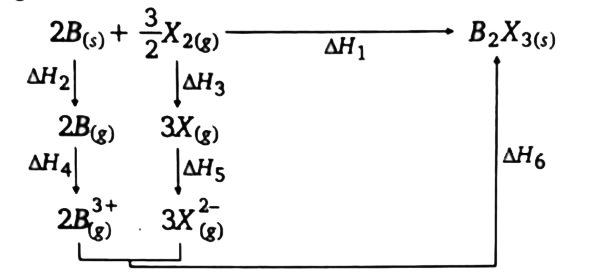Consider the following two reactions:
i. Propene +H2→ Propane, ΔH1
ii. Cyclopropane +H2→ Propane, ΔH2 Then, ΔH2−ΔH1 will be:
0
2BEC−C−BEC=C
BEC=C
2BEC=C−BEC−C
The correct Answer is:B
CH3−CH=CH2+H2→CH3−CH2−CH3,ΔH1=(BEC=C+BEH−H)−(2BEC−H+BEC−C)
 +H2→CH3−CH2−CH3,
+H2→CH3−CH2−CH3,
ΔH2=(BEC−C+BEH−H)−(2×BEC−H)
ΔH2−ΔH1=2BEC−C−BEC=C
Topper's Solved these Questions
- Chemical Thermodynamics and ThermochemistryBook:OP TANDONChapter:Chemical Thermodynamics and ThermochemistryExercise:Objective Question Level B Set II
Explore 8 Videos
- Chemical Thermodynamics and ThermochemistryBook:OP TANDONChapter:Chemical Thermodynamics and ThermochemistryExercise:Assertion Reason Type Question
Explore 29 Videos
- Chemical Thermodynamics and ThermochemistryBook:OP TANDONChapter:Chemical Thermodynamics and ThermochemistryExercise:Set 2
Explore 18 Videos
- CHEMICAL KINETICSBook:OP TANDONChapter:CHEMICAL KINETICSExercise:LINKED COMPRESHENSION TYPE QUESTIONS ( SECTION-VI)
Explore 4 Videos
- CLASSIFICATION AND NOMENCLATURE OF ORGANIC COMPOUNDS Book:OP TANDONChapter:CLASSIFICATION AND NOMENCLATURE OF ORGANIC COMPOUNDS Exercise:INTEGER
Explore 2 Videos
Similar Questions
The ethalpies for the following reactions at 25∘C are given as:
12H2(g)+12O2(g)→OH(g),ΔH=10.06kcal
H2(g)→2H(g),ΔH=104.18kcal
O2(g)→2O(g),ΔH=118.32kcal
Calculate the O−H bond enegry in the OH group.
View SolutionThe enthalpies for the following reactions (ΔHΘ) at 25∘C are given below.
a. 12H2(g)+12O2(g)→OH(g)
ΔH=10.06kcal
b. H2(g)→2H(g),ΔH=104.18kcal
c. O2(g)→2O(g),ΔH=118.32kcal
Calculate the O−H bond energy in the hydroxyl radical.
View Solution
Knowledge Check
The equation ΔH=ΔH1+ΔH2ΔH3
AKirchoff s equationBvant't Hoff isothermCvan 't Hoff isochoreDHess's lawConsider the following set of reactions:
CHCl2COOH+NaOH→CHCl2COONa+H2O ΔH1=−12830Cal
HCl+NaOH→NaCl→NaCl+H2O ΔH2=−13680Cal.
NH4OH+HCl→NH4Cl+H2O ΔH3=−12270Cal.
Select the correct option(s) :AEnthalpy of neutralization of CHCl2COOH by NH4OH is −11420Cal.BEnthalpy of dissociation of NH4OH=1410CalCEnthalpy of dissociatiion of NH4OH=1410Cal.DEnthalpy change for the reaction H2O→H++OH−is−13680CalFor the equations
C(diamond)+2H2(g)→CH4(g)ΔH1
C(g)+4H(g)→CH4(g)ΔH2 Predict whtherAΔH1=ΔH2BΔH1>ΔH2CΔH1<ΔH2DΔH1=ΔH2+ΔvapH(C)+ΔdissH(H2)
Consider the reactions
(i) S(rhombic)+3/2O2(g)→SO3(g),ΔH1
(ii) S(monoclinic)+3/2O2(g)→SO3(g),ΔH2
(iii) S(rhombic)+O3(g)→SO3(g),ΔH3
(iv) S(monoclinic)+O3(g)→SO3(g),ΔH4
View SolutionIn the reaction: H2+Cl2→2HCl,ΔHCl,ΔH=194kJ. Heat of formation of HCl is
View SolutionConsider the following reactions
(i) A(s)→A(g):ΔH1
A(g)→A+(g):ΔH2
A+(g)→A2+(g):ΔH3
then according to the given information, select the correct statement(s)
View SolutionConsider the following Born-Haber's cycle:

(Where ΔH1,ΔH2,ΔH3,ΔH4,ΔH5andΔH6 are in kJ/mol)
Then according to given information the correct statement is/are:
View SolutionFor the reaction 2H(g)→H2(g), the sign of ΔH and ΔS respectively are :
View Solution

